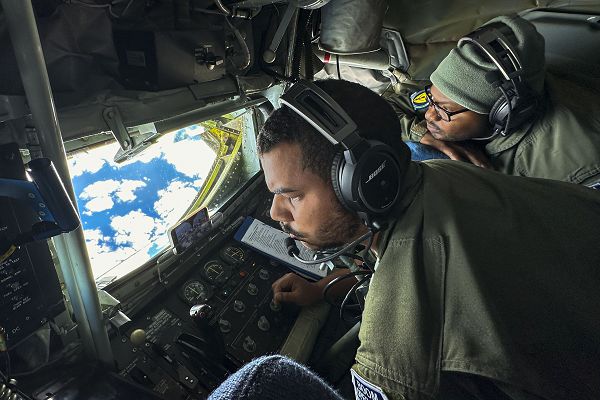
Mildenhall, England. (November 30, 2023): They are the vital link during mid-air refueling and give the Air Force the ability to fly anywhere in the world non-stop. In this photo by Airman 1st Class Christopher Campbell, Airman 1st Class Anthony Toliver and Technical Sergeant Fernando Brome, boom operators with the 351st Air Refueling Squadron, lower the boom during mid-air refueling. Since the beginning of the Cold War, enlisted boom operators have played a leading role in the Air Force’s crucial ability to keep planes flying longer and farther.
Boom operators are responsible for the delicate task transferring aviation fuel from “flying gas stations,” in this case the KC-135 Stratotanker. For the past 60 years, the reliable KC-135 and its many versions have extended America’s reach around the globe. Able to fuel two planes at once, these super tankers can dispense over 30,000 pounds of fuel and carry 50,000 pounds of cargo while cruising at over 530 miles per hour. In addition to its duties as a mobile petrol station, the KC-135 can also be used to transport patients during aeromedical evacuations.
The boom operator is stationed in the rear of the plane to control what is called the “drogue.” The drogue is shaped like a bad mitten collar attached to a hose trailing behind the aircraft. The boom operator manipulates the drogue into position using 3-D cameras and direct coordination with both pilots. This is a delicate and potentially dangerous operation where one mistake at such close range and at high speeds can be catastrophic.
It’s a little tricky for the receiving pilot too. Each receiving aircraft is fitted with multi-point refueling points consisting of special pods mounted on their wingtips. The pilot makes an approach to connect with the drogue which is stabilized in flight by the bad mitten “collar” which acts as a funnel. The receiving probe is designed to be retractable when not in use, particularly for high-speed aircraft. The valves in the drogue are “NATO standard” which mean the KC-135 can refuel aircraft from many nations.
All Air Force Boom Operators, in addition to basic training, spend a month flying tankers out of Joint Base San Antonio, Texas, and go on to three weeks survival training. The school to learn how to successfully manipulate the boom last four months. An enlisted position, boom operators work with many diverse types of aircraft, day and night, mild weather or bad. When they are not lowering the boom, in-flight fuel specialists function as regular crew, handling passengers, cargo, and tending to medical patients during evacuations.
These boom operators with their steady nerves literally determine the reach of America’s air forces around the world.


